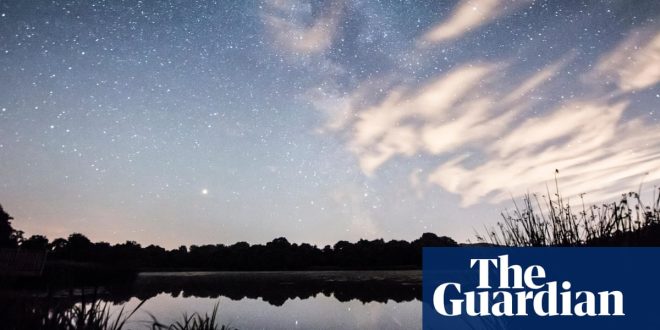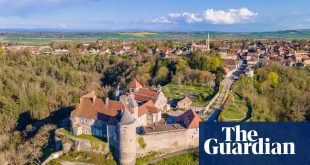As I slip out of my clothes, my stomach pinches with fear. The beach – Pevensey Bay in East Sussex – is inky black and eerily empty. The sound of slurping seawater seems noisier than usual, the air smells brinier than it does during the day, and the night breeze feels cool and sharp.
My previous efforts at night swimming have been unsuccessful – the current too strong, the waves too wild, my imagination too extravagant. But tonight I’m determined. My daughter Imogen shouts to encourage me and the emergence of a full moon steadies my nerves. Within moments I am bobbing about amid glittering moonshine, laughing and gasping, and wondering why it has taken me half a century to do something as simple and magical as a moonlit dip.
Night swimming is the latest in a series of nocturnal journeys that have changed how my family and I view darkness. What was once a time for moving indoors and turning on lights has become a place for travel and adventuring. We call these lightless excursions our “night journeys”, and they began during a long stint of insomnia triggered by grief. Reluctant to take medication, I slowly overcame my dread of darkness by embracing my wakeful nights, seeing them as a gift of extra, exotically located time.
My first insomniac months were spent reading, writing and drawing – indoors. But one spring night I pulled a mattress on to my balcony and lay gazing upwards at a black sky sequined with stars. The sense of restful space stretching endlessly upwards seemed to release me from the burden of worry and grief. For the first time in months, I slept.
According to a recent study from the University of Derby, being safely out at night can have a dramatic impact on our wellbeing. Its author, psychologist Dr Christopher Barnes, told me that “having a connection to the night sky is important because of what it gives us – a place to be restored, inspired and free”. Barnes’s investigations found that people out after dark used different language: “Darkness seemed to be a deeply tranquil and restorative experience that often brought a sense of peace and a chance for contemplation.”
Other studies have found that being beneath high ceilings alters how we think, making us more open-minded. Meanwhile, studies of the “mind after midnight” suggest that our after-dark brains perceive things differently. At night, and beneath vast skies, we quite literally see the world through a fresh, more imaginative lens. We are no longer our day selves. We are our night selves. By this point I was so enthralled by the night (and my night self), that I began venturing further afield. With a pair of astronomical binoculars and an iPhone stocked with stargazing apps, I took to walking through nearby meadows. I followed owl calls, watched meteors and listened for night-migrating birds.
Eager to share this new “land”, I persuaded my twentysomething and teenage children to join me on night journeys. I wanted to disconnect them from their screens, but I also wanted to temper the fear of darkness that plagues so many of us (more than 37% of children are frightened of the dark, and almost two-thirds of women are too scared to go out alone at night). I hoped to do this by showing them the astonishing beauty and alchemy of night.
Our first outing was to a Sussex forest, where we hiked on a night that was so pitch black we had to use torches. Exciting, yes – but not the experience of darkness I had in mind. From then on, I matched adventures with phases of the moon. New moons for stargazing and wild sleeping, full moons for walking and wildlife watching. We swapped birthday celebrations in a pizza restaurant for firepit nights amid the sleeping trees (yes, trees sleep). My son and I spent nights out watching badgers and foxes from a pop-up hide in our garden.
Meanwhile, Imogen, joined me on guided night walks where we yomped silently over the South Downs with a group of women whose presence we only ever sensed, as we neither saw nor heard them – a strangely intimate experience quite unlike a diurnal group walk. We hear more acutely in darkness, and sound travels further at night, so the nocturnal soundscape is also very different from its daytime counterpart.
But what most struck us on our night roamings was the altered smellscape. At first we assumed this was thanks to night-perfumed plants attempting to lure pollinators, but I later learned that our sense of smell is at its most acute after dark.
One night, my daughter Bryony suggested we go rock-pooling. With a pair of UV torches, we crept along the beach of Birling Gap. Beneath the violet beam of our torches, the rock pools sprang into Technicolor aquariums as crabs, tiny shrimp and shards of shell turned to fuchsia pink, neon green and brilliant turquoise. Since then, I’ve discovered biofluorescence maestro David Atthowe, who runs Reveal Nature and offers guided night ambles in Norfolk and Suffolk that reveal the hidden colours of slugs, lichen and fungi. An upgraded UV torch is now an essential item in our night-journeying kit.
From the Arctic Circle’s aurora borealis to Spain’s dancing fields of fireflies, nocturnal darkness bestowed a sense of magic and mystery on all our journeys. But the greatest gifts of spring and summer were on our (British) doorstep: the melodious nightingale (mid-April to late May) and the humble glowworm (late May to early September, peaking in June and July). Our first nightingale foray was at the Knepp estate in West Sussex, where we walked to the extraordinary song of a dozen pairs of nightingales. This year I’m walking with folk singer and nightingale expert Sam Lee, whose human-avian duet nights in secret locations include firelit talks on the mythology of these rare birds.
Our hearts were stolen by the humble glowworm. On summer nights these (female) bioluminescent beetles glow from about 10pm until midnight, although I’ve also encountered them shining in the wee hours. Like most nocturnal creatures, glowworms are in decline, thanks to artificial light, pesticides and building work. And yet they’ve been spotted across the country, gleaming like tiny backlit emeralds (for tips on where to look and join guided glowworm walks in the UK, visit glowworm.org.uk and the Wildlife Trust). Coming across a glowworm feels like finding a nugget of gold, making a glowworm walk perhaps the most satisfying (and cheapest) of all night journeys.
In our enthusiasm for the other-worldliness of night, we have also joined a lantern-lit walk in Liverpool’s cathedral cemetery, explored the gas-lamp-lit streets of London, attended astronomy courses at the Observatory Science Centre in Herstmonceux, East Sussex, and visited Dark Sky Reserves in Bannau Brycheiniog (formerly the Brecon Beacons), Yorkshire Dales and Exmoor.
When we welcome the darkness, we give nocturnal nightlife a better chance of survival. Stars and meteors are clearer. Moreover, we keep our night vision working, we sleep better and enjoy improved mental health (according to a new study), and we encounter our rewired night selves – and discover darkness in all its transcendent and adventurous guises.
Annabel Abbs is author of Sleepless: Discovering the Power of the Night Self, published by John Murray (£16.99). To support the Guardian and the Observer, buy a copy at guardianbookshop.com. Delivery charges may apply.
 Top Naija News – Nigeria News, Nigerian News & Top Stories Top Naija News – Nigerian Newspapers, Nigerian News. topnaijanews is a daily Nigerian newspaper covering Latest News, Breaking News, Entertainment, Sports, Lifestyle and Politics.
Top Naija News – Nigeria News, Nigerian News & Top Stories Top Naija News – Nigerian Newspapers, Nigerian News. topnaijanews is a daily Nigerian newspaper covering Latest News, Breaking News, Entertainment, Sports, Lifestyle and Politics.




